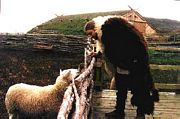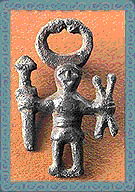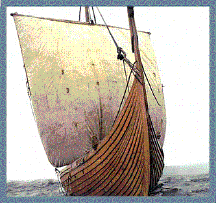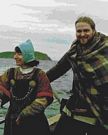
Full Circle - First Contact
"... Modern human beings evolved in Africa, and until 5,000 generations ago, that's
where all our ancestors lived. But then some of them left Africa and found the world
at their feet. ...
... Our Ancestors left Africa between 100,000 and 120,000 years ago.Coming up
out of the Middle East, some of them turned left into Europe, and others turned
right into the further reaches of Asia. Their descendants would not meet again
until 100,000 years later ...
... It became a world of almost infinite diversity. The human race was divided into
10,000 or 20,000 bands, few with more than a thousand people, but each with its own
language and customs and ways of adapting to the local environment. ... But there
was also a great underlaying uniformity: all the people of the earth were hunter-gathers
who made their living in the same basic way. ..."
Full Circle - First Contact "is the story of how some people finally crossed the
Atlantic gap, and how the descendants of the People Who Turned Left met the descendants
of the People Who Turned Right ....
... It happened in the Strait of Belle Isle 1,000 years ago..."
from Gwynne Dyer's commentary to Full Circle - First Contact
©the Newfoundland Museum
Some turned Right....
Some of the groups of humans who left our original home in Africa made a sharp right
turn once into the Middle East. This turned out to be the long road. Moving to the
east, these tribes would populate India and China. Some would turn right again, offshore
in dugout canoes into the Pacific to Australia. As the land ended to the east, they
would also turn north into Siberia. About 15,000 years ago, the vast glaciers of
the last Ice Age had started to melt and draw back, for a relatively short time exposing
a narrow land bridge that ran from Siberia to Alaska.
Those first hunters gatherers who had turned right once again followed the game
into vast new continents, full of animals who had never seen a human being before.
For them, game was plentiful, and if not, there was always more to be found by
traveling just a little further over the next hill. The people would expand to
fill all of the new continents, but there was a lot of land, and not really all
that many humans. In a few places, such as Mexico and the Ohio Valley, rich soils
and limited land lead to the development of agriculture. This wasn't easy, for
there were not very many large animals around that were all that suitable for
domestication. For most of the tribes however, the ancient methods of making a
living as hunter gatherers continued to work fairly well. They had a lot of experience
with stone cutting tools, and working available materials into what they needed.
Generally, the individual tribes were isolated enough from each other that they
were able to develop their own distinctive languages and cultural traditions,
into what we today call the individual First Nations.
The eastern coast of the North Atlantic was thus relatively sparcely populated at the
turn of the first millennium. Three main cultural groups are part of the story of
'First Contact'.
The 'Recent Indian' culture are the people who lived in Newfoundland, Labrador and
northeast Quebec. They are the ancestors of the Beothuk of Newfoundland and the Labrador
and Quebec Innu. The great abundance of Ramah Chert found in their sites is part of what
makes them distinctive to the modern archaeologist.
The 'Proto Mi'Kmaq' culture are the people who lived around the southern shores of
the Gulf of St Lawrence circa 1000 AD. As the name suggests, they are the ancestors
of the modern day Mi'Kmaq First Nation. Centred in villages in such fertile areas
as the Miramichi River, these people added the plentiful fish to their hunting and
gathering.
The "Thule" culture are a people who did not arrive in the eastern arctic
until about 1200 AD. The ancestors of the modern day Inuit, they had been moving across
the north from Alaska into Baffin Island and northern Greenland.
All of these North American peoples had reached the final limits to their eastward
expansion because of the barrier of the North Atlantic. They all lived as hunter
gatherers, using similar types of tools. There were differences between each culture,
specialization based on the different type of animals hunted and the type of raw materials
available to them. They could hardly imagine what was coming across the eastern ocean
towards them.
...and some went Left.
The humans who turned left out of Africa traveled up through the Middle
East, and then were diverted by the Black Sea into Eastern Europe. Again there was
a split, some heading west along the river valley of the Danube, the others
traveling north into the Russian plains. Small groups would keep pushing west, into Spain, and north,
following the retreating glaciers into Scandinavia and the British Isles. And there
the expansion stopped. Halted by the barrier of the Atlantic Ocean, the Left branch
of humanity were still living as hunter gatherers. The pressure for change was slowly
building up, however. No longer could new hunting territory be found 'just over the
next hill'. People were starting to pile up in the areas with the highest concentration
of animals - the fertile river valleys. Soon there were too many humans for ever shrinking
space and resources. A new way of providing food had to be found.
Starting as long ago as 10,000 BC, humans living in the river valleys had started
to raise and domesticate animals such as sheep, goats and pigs. They also had
learned that the same seeds they had gathered for food could be saved, and buried
to produce controlled grain crops. As the food supply came to be under human control,
time could be spent in inventing more ways to improve daily life - textiles, pottery
and metal tools for example. Larger populations required organization and control,
group projects such as irrigation systems and temples needed protection. No longer
would the ancient system of extended family tribal groups function, now there
could be nations ruled by kings claiming vast territories.
The peoples in what is now Scandinavia would adapt the farming methods to suit the environment
of their northern homelands. Their basic system was 'crofting', mainly raising sheep,
cattle and pigs with smaller gardens. Most people lived in large extended family
households, each in a separated farmstead. They became especially skilled at metalwork,
ship building and textile production. Although Scandinavia is a huge area, the people
there shared similar languages, religion & world view, writing system, social systems
and material culture. To mainland Europe, those living in the separate locations of modern
Denmark, Norway and Sweden were 'the Northmen' - what today we call the Norse. By
800 AD, the stage was set for the begining of what would come to be called the Viking
Age.
'From the Fury of the Northmen...'
...Starts a prayer from the 800's, voiced by an English priest. It was a plea
for protection from Viking raiders, who seemed to explode out of their Scandinavian
home lands in the last decade of the eighth century. Fierce, independent, possessing
technologically superior ships and navigation skills, and without any reverence
for the Christian church, the Vikings would cut a wide swath through any part
of Europe with a coast line for 200 years. But just who were these Vikings, and
what kind of culture had created them?

What is modern Scandinavia was divided during the Viking Age into a series of small kindgoms, changing shape and growing every larger over the period. There were differences bewteen the peoples living in what would become modern Norway, bounded by the North Atlantic; Sweden, bracketed by the Baltic; and what is now Denmark, tucked up between them. The people there, although distinct to themselves, appeared similar to
those living in the rest of Europe. They were referred to as 'the North Men', shortened
to 'Norse'. Norse is the term used by archaeologists to refer to the material culture
of these Scandinavians. 'The Viking Age' refers to a specific period of their history,
usually starting with the raid on the English monastery at Lindisfarne in 793, and
ending with the conquest of England by William of Normandy in 1066. At the height
of their expansion around the year 1000, the Norse would have control of central England,
Northern Scotland, Central Ireland, and Iceland. They would have colonized Greenland
and explored as far west as the Gulf of St Lawrence. To the east they controlled
Russia, and had regular trade down the rivers there into Constantinople and the Middle
East.
First, it is most important to realize that going 'a viking', going raiding, was only
a job for a very few of these Scandinavians, and only a summer job at that. Our
impressions of the Norse are coloured by the fact that most of the written descriptions
we now have were recorded by the very priests who were the horrified survivors. Often
described in those Christian chronicles as 'godless heathens', the scribes seemed
to have missed the main point : the Norse were NOT Christian. To them a stone church
filled with gold and silver treasures was nothing more than a big opportunity for personal
wealth, and a poorly defended one at that. No one at the time seemed to consider
that for every Viking raider there had to be a hundred Norse back in Scandinavia
to support them. Ships had to be built of harvested timber, iron dug and formed into weapons,
sheep raised for wool to be spun and woven for clothing, and farms worked to feed
them all.

Experts differ as to why the Norse so suddenly took to their ships on voyages of
raiding, trade, exploration and colonization. Certainly, there was an improvement
in the climate in the late 700's. Although only an average increase of a few degrees,
its effect on already marginal areas such as Scandinavia was dramatic. Even an extra two
weeks of good farming weather can make the difference between a poor harvest and
regular years of bounty. Increased food means increased population, as well as more
free time available for other labours. One of these activities was the expansion of the political
control of the minor kings within Scandinavia. To many of the fiercely independent
Norse, this was reason enough to seek new lands.
The Land, the Gods, and a northern view of the world:
It is almost impossible to separate the world view of the Norse from the stamp of
their northern world. The physical environment of Scandinavia marks the religion,
technology and lifestyle of the Norse. Norway is covered with high and inhospitable
mountains, with farm land confined to narrow strips at the ends of the long fiords which
cut the coast behind a chain of islands. Sweden is dense pine forest and rock to
the north, with the south covered with lakes and bogs. Denmark is made up of a chain
of islands and a narrow marshy peninsula. All this combined to isolate people into extended
family groups, each centred on a small area of good soil often isolated from the
next farm by mountains, forest or marsh. This created a sense of independence, self
reliance and strong kinship ties.

The life was unpredictable and harsh. Often despite the best of efforts, all you could
do was strive - and fail. This produced a sense of fatalism that underscores all
of Norse belief. Their world was controlled by a pantheon of gods, remote, uncaring
and concerned with their own objectives. Each had a specific area of control : Odin,
the All Father, master of the runes and occult knowledge, lord of battle. Thor, the
hammer thrower, with huge appetites, humour or anger, controller of weather. Frey
& Freya, brother and sister, symbols of growth and fertility. The gods struggled constantly
against the powers of darkness, giants and monsters such as Fenrir the wolf and the
World Serpent. In the final battle of Ragnarrok, the gods would defeat evil, but only
at the cost of their own destruction. When the gods themselves are doomed to fail, how
can mere humans hope to prevail? Better to die sword in hand and defiance in your
last breath. After death, the Norse believed in an active afterlife, so the dead
were buried with their possessions. An important chieftain might be laid within his ship, surrounded
by weapons, tools and camping gear - to the vast benefit of modern archaeologists!
The Longship:
With so much of Scandinavia dotted with islands, water transportation was the obvious,
if not only, method. Very early, the Norse became skillful seamen, developing a unique
construction method for their ships which was superior to any other used in the world at that time.
Their vessels, called 'longships' were made of thin, flexible
planks, each overlapping each other and secured with iron rivets. The hulls swept
up at bow and stern, and formed a graceful curve up from the long keel beam out to
distribute the load over the water. Each ship would be equipped with oars as well as a sturdy
and effective square sail. The result was a warship that would float a full crew
in less than one metre of water, or a cargo ship that would ride over the waves in
North Atlantic storms.

Combined with technologically advanced ships, the Norse also developed expert skills
as navigators. They were able to determine relative location north / south with
simple instruments that measured the height of the sun or the pole star. This simple
discovery enabled them to do what no other sailors of the time dared, leave the sheltered
coast and voyage straight across the North Atlantic Ocean. Combined with knowledgeable
observations of cloud formations, currents and winds, they effectively traveled west from Norway.
A chain of settlements were founded : the Shetlands, the Faeroes,
Iceland, Greenland. Each served as a stepping stone to the next, most were only
a couple of days sailing from the next.
Westward to Vinland
The final step in this steady progress westward was the largest, and the leap that
proved impossible to maintain - North America. About 985, two separate colonies were
founded by Eric the Red in a new territory west of Iceland. He named the place 'Greenland'
because "People would be more likely to go there if the place had a pleasant name"
- perhaps the first real estate scam ever recorded. Truth was that Greenland was
less hostile at the turn of the first millennium than it would become later. His
colony, originally started with about 450 or so people, would grow to an estimated 5000
people at its height, a colony that would endure for over 400 years.

It would be Eirc's son Leif, perhaps hoping to equal his father's exploits, who made
the last step in the westward chain. Some time about 1000 AD, he would set sail to
explore the lands seen from a distance by a storm driven merchant a decade before.
The voyage to his proven destination, the tip of the Northern Peninsula of Newfoundland,
would cover almost 4000 km sailing distance, almost the same distance back to Norway.
Along the way he would name the new territories he explored : Helluland, or Flat
Rock Land (likely Baffin Island), Markland, or Land of Forests (Labrador), and Vinland,
or Land of Grapes (the Gulf of St Lawrence).
We know that 1000 years ago, the Norse built a series of turf walled long houses at
L'Anse aux Meadows Newfoundland. The remains of three large houses with their related
outbuildings were uncovered in the 1960's. Indications from the artefacts found there
show that the Norse here had traveled even further south, at least as far as the Gulf
coast of New Brunswick.

It is here that humanity would come Full Circle. The Norse explorers would find that
the new land they thought they were the first to discover was in fact occupied
already. At First Contact, as would be the case with so many other meetings 500 years
later, the Europeans would judge the value of the people based on their own ideas of
valuable technology and find them lacking. Trade would be very one sided, tensions
would escalate, eventually hostilities would explode. For the Norse, who had come
so far, the new lands would prove more trouble than they were worth. The First Nations may
have driven out the newcomers, but the best they would achieve is a few centuries
peace before they were shattered by an invasion they could not resist.
go on to part two....
Note that the section 'Full Circle - First Contact' is based heavily on Gwyn Dyer's orginal commentary to "Full Circle" - which is copyright the Newfoundland Museum.
 Dark Ages Re-Creation Company
Dark Ages Re-Creation Company







